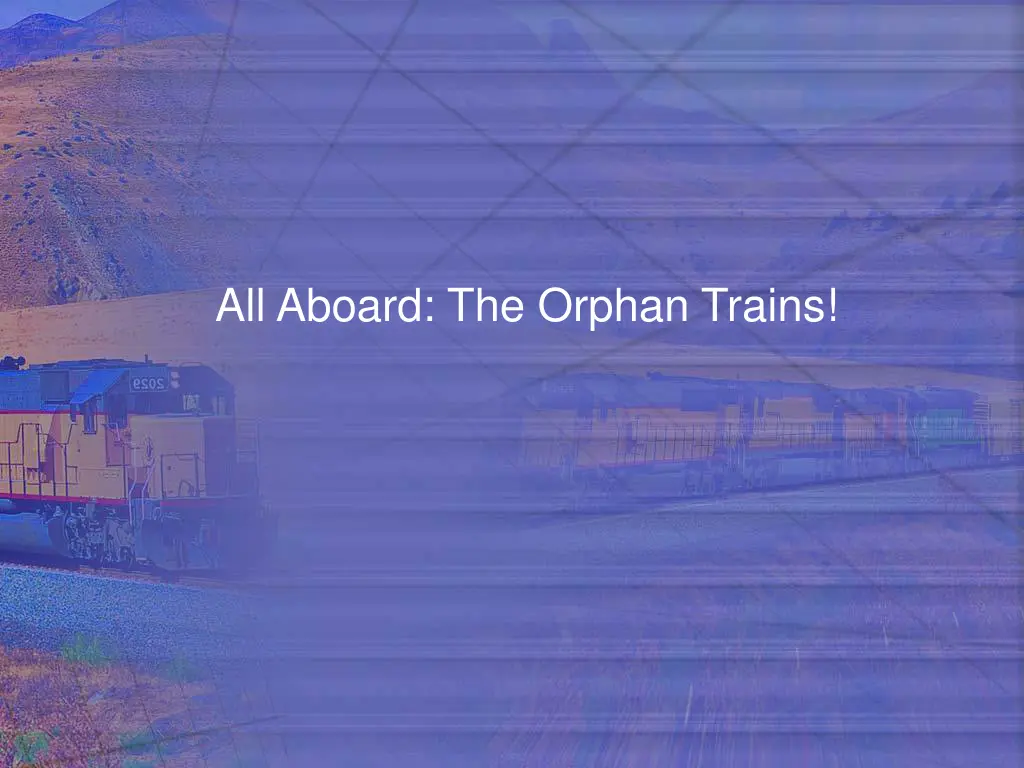
Discover the History of Orphan Trains and Waifs
Explore the intriguing background of orphan trains in the 1800s, shedding light on the journey of homeless children placed with new families. Uncover the tales of waifs and the challenges they faced, including a protest parade for better homes in New York. Delve into poems and images depicting this poignant era of history.
Download Presentation

Please find below an Image/Link to download the presentation.
The content on the website is provided AS IS for your information and personal use only. It may not be sold, licensed, or shared on other websites without obtaining consent from the author. If you encounter any issues during the download, it is possible that the publisher has removed the file from their server.
You are allowed to download the files provided on this website for personal or commercial use, subject to the condition that they are used lawfully. All files are the property of their respective owners.
The content on the website is provided AS IS for your information and personal use only. It may not be sold, licensed, or shared on other websites without obtaining consent from the author.
E N D
Presentation Transcript
Take a Trip! You are going on a very looooong trip. You are going to be gone a looooong time. Rules: With an assigned partner, list the items you would bring. I won t tell you where you re going You cannot talk, add one item to the list and pass it to your partner. Your partner then adds one item. Keep exchanging the paper and adding items until told to stop. You may not repeat items already on the list.
The Rules Have Changed! You are now MOVING to a new location. I can t tell you what the climate is like there because I don t know where you re going. Using your same list, you will need to prioritize the items you have chosen because you are only allowed a small carry-on size suitcase. Pass the paper back and forth the same way as the first list, but this time you can either circle an item already written or add something new. Don t exceed your allowed space!
Orphan Train Background Info During the 1800s there were many homeless or orphaned children on the streets of New York City. They did anything they could to survive including stealing and begging. It was hard figuring out what to do with them, so a few organizations came up with the idea to send them westward and place them with new families. For some, this worked well, but for other children, things weren t that great. Children were especially wanted to do hard labor in the fields or home.
Image 1 of 3, Only a waif [poem] Washington, D. C., 1891. -- Pie
Image 2 of 3, Only a waif [poem] Washington, D. C., 1891. -- Pie
Image 3 of 3, Only a waif [poem] Washington, D. C., 1891. -- Pie
Childrens Protest Parade: They want better homes (New York)
And the Arizona Story No children were placed by the Children s Aid Society in Arizona. However, an orphanage run by Catholic nuns placed their wards in Arizona. In 1904, Irish children traveled from New York City to the mining towns of Clifton and Morenci in Arizona. The nuns placed 40 children into Catholic families in Clifton/Morenci. Anglo residents noticed that the nuns were placing Anglo children with Mexican families, and they became very angry even though the Mexican families were the Catholics in the area. It didn t take long for the Anglo community to be in an uproar and the townspeople formed a vigilante group that kidnapped the children from their new homes and took them by force. The group placed the 40 children into Anglo families even though they were not of the same religion. The nuns later fought in court for the children to be returned to New York City because they felt responsible for the children. The U.S Supreme Court sided with the vigilantes.
PLACEMENT OF ORPHAN TRAIN RIDERS 1. On your railroad map, you will use an atlas to locate the 5 U.S. cities below. Mark them with dots on your map. Label the dots using the city names. Create a legend on the map. Draw five boxes for the 5 travelers using a different color for each one. Trace/draw the route from New York City in the corresponding color showing where each orphan would travel. Colors may overlap. If the city is not near a railroad track, assume the rest of the journey was made by another form of transportation. 2. 3. Traveler Alice Ayler Arthur Smith Lorraine Williams Lee Nailing Arizona riders Destination Kansas City, Kansas Clarinda, Iowa Kirksville, Missouri Clarksville, Texas Clifton, Arizona
